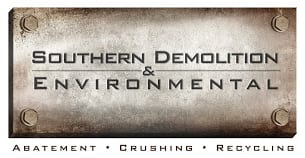This past fall, Southern Demolition & Environmental was hired to crack open a bank. The client, a safety consultant, had been operating next to a closed branch of Pinnacle Credit Union, and since they were expanding and needed more space, they bought up the entire lot, and contacted Southern to talk about demolishing the remaining structure. It took about a week to conduct an estimate, and another week to negotiate a proposal. Once Southern had secured a permit and posted it, the company held public meetings, put a start date on our project calendar, and mobilized the necessary equipment and staff for the job.
At first, Southern’s crew focused on the vertical structure, which was typical for a reinforced steel concrete commercial structure. After taking down the walls and roof, the company used an excavator and grapple to clear out the concrete slab foundation, whose footers were about 16-inches deep. This process took about five days, and again using the excavator, it wasn’t difficult to tear the wheel bolt door from the hinges. The vault itself, however, had been more or less cast in place. Both the 30-inch concrete walls and the 36-inch concrete floor had been reinforced by steel rebar, and only a powerful hydraulic hammer could break them down.
During cleanup, Southern gathered 90 cubic yards steel and ferrous metals from the structure for recycling, and took 300 cubic yards of concrete to the crushing yard, where it was pulverized into gravel. Because of Southern’s diligent work harvesting and sorting these materials, only 60 cubic yards of waste from this project went to the landfill. Once this was clear, the crew removed silt fences, and took a few final steps to improve the soil, spreading out grass seed and fertilizer, and putting down a layer of straw on areas that needed mulch. Southern’s operator also ran over the project area several times with the excavator. (Since the machine weighs over 30 tons, this step can go a long way towards compacting the earth and helping with recovery.) Seven days after the start date, the permit and other signage around the site were taken down, and the company’s work was complete.
Taking apart Pinnacle Credit Union’s branch was probably easier than most bank robberies. But it still required a lot of careful planning: for a demolition project like this one, contractors are generally required to notify the state at least ten days in advance, and although this process can vary from one city or county to another, there were a few minimum steps that needed to be taken care of before we could start working. One of these was conducting an asbestos inspection, securing asbestos clearance letter, and a “Rodent Letter,” which certified that the building was free of any rodents. “Call Before you Dig” (811) and local utility companies were notified, utilities were disconnected, and the building was checked for animals and squatters prior to demolition.
If you’re trying to learn more about the permitting process, check out this primer on the basics of how to apply, or contact Southern’s office in Atlanta with any questions.
